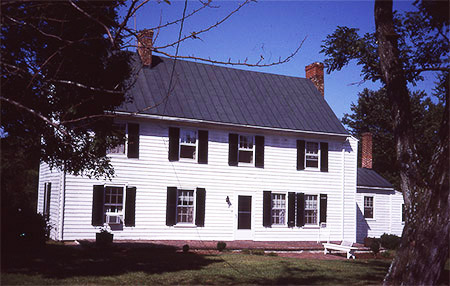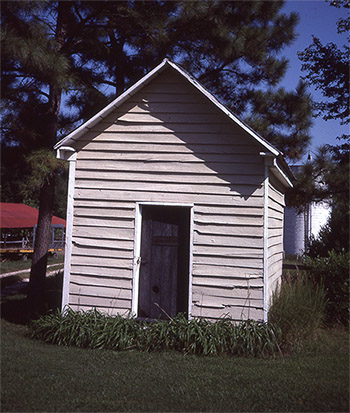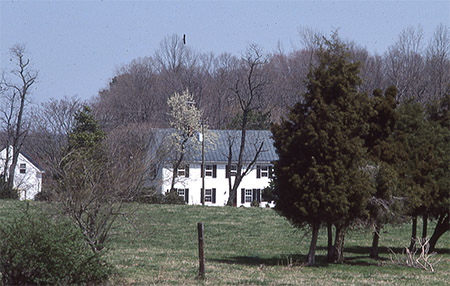 |
Nutshell
This site was lost to history when
Hanover County razed it on May 5, 2016.
An Historical Background
Compiled by Hanover County Historical Commissioners
Alison Ross, Charles Schmetzer, Wanda Garrett and Brenda Pennington Click here to read a letter to the editor of the Hanover Herald-Progress, August 21, 2014: Hanover County in a "Nutshell" |
 |

Nutshell in 1985
|
|
Owners of Nutshell
Nutshell was owned by Philip Henry Winston (1818-1863) and his wife Catherine during the Civil War. Philip Henry Winston was one of nine children of Philip Bickerton Winston and Sarah Madison Pendleton. His other brothers and sisters were William Overton Winston, Henry Pendleton Winston, Bickerton Lyle Winston, Philip Henry Winston, John Robinson Winston, Edmond Thomas Winston, Barbara Joanna Winston, Joseph Pendleton Winston, and Octavius Madison Winston. Catherine Robinson Berkeley (b. 1806-November 20, 1894) was the daughter of Nelson Berkeley, Jr. and Lucy Robinson. Miss Catherine married Philip Henry Winston on December 11, 1849 after the death of her first husband. ( ArlisHerring.com accessed 15 February 2014).
Old Homes of Hanover County indicates the Winstons built the home. On court days dinner was served at “Nutshell” and people would “rush over from the court house, as the food served here was considered better than that served at the Tavern, at that time.”
According to A Refugee at Hanover Tavern: The Civil War Diary of Margaret Wight, edited by Dale Paige Talley and Shirley A. Haas, Catherine and Philip H. Winston were friends of Margaret Wight and owned Hanover Tavern and 626 acres around Hanover Courthouse. In January 1861 they sold 262 acres and the hotel to Cleavers S. Chisholm and wife Amizela (page 68).
Philip H. Winston died in 1863 and is buried at Blenheim Cemetery on Route 646. Miss Catherine Winston is buried in Richmond.
According to A History of Hanover Courthouse, Virginia by Steven Anthony Colvin, Miss Mary Jane Hawe taught at Nutshell as well as nearby Courtland and Wilton in the second half of the nineteenth century (page 10). A newspaper article by Mary Overton Haw in Hanover County, Virginia: A Retrospective, a book of articles put together by the Hanover County Historical Society, gives some ownership history of Nutshell. Edmund Winston of Wood Grove, a cousin of Philip H. Winston, bought the property, added to it, and rented it to his grandson John Woolfolk and then his son, Jourdan Woolfolk took ownership (page 23). |
 One of Nutshell's outbuildings, One of Nutshell's outbuildings,
thought to be the Smokehouse, 1985 |
 |
The Fields Family at Nutshell
Perhaps the most noteworthy legacy of the “Nutshell” plantation was that Martha Ann Fields and her children were slaves there from 1855 until they escaped to Fort Monroe in 1863. We know much about their family, the Nutshell plantation, and their lives because Martha Ann’s son George Washington Fields wrote his autobiography entitled Come On, Children: The Autobiography of George Washington Fields, Born a Slave in Hanover County, Virginia. It was recently rediscovered in museum archives in Hampton, Va., and is a valuable account of a slave’s path to freedom and success.
Martha Ann Fields and her family’s life story is also told by Drusilla Pair, a genealogical researcher and Ajena Rogers, a historical interpreter and a Fields Family descendant in their performance “Flight to Freedom: The Fields Family and Freedom’s Fortress.” They recently performed at Hanover Tavern in November 2013 and have more performances scheduled.
Martha Ann Berkeley, (b. December 18, 1813 at Clover Plain) was a slave owned by Miss Catherine. She married Washington Fields when she was 19 or 20 and they had 11 children together.
George Washington Fields was born April 25th, 1854 at Clover Plain. An annotated version of George Washington Fields’ autobiography The Indomitable George Washington Fields: From Slave to Attorney by Kevin M. Clermont, combines historical images with Fields’ account to describe in detail the area around Hanover Courthouse during the 1860s.
|
|
George reveals in his autobiography that Winston was poor and that the family moved with Miss Catherine to Hanover Courthouse in 1855. The Winstons had owned about 75 slaves at this time. Fields’ account of the plantation describes the kitchen building where his mother worked as on a brow of a hill above a swamp as well as some of the outbuildings surrounding the house. He shares a few stories of the cruelty and brutality that the Winston’s showed towards their slaves and gives a colorful description of the types of work that a young slave was expected to do on the plantation. An online version of Clermont’s book and Fields’ autobiography can be found at http://issuu.com/cornelllawschool/docs/gwfields/56.
Escape from Nutshell and George Washington Fields
From The New York Times, "No More a Slave," also by Kevin M. Clermont, on 25 October 2013 we find the following narrative:
“Fields was born into slavery in 1854. But he won his freedom when, in 1863, his mother, Martha Ann Fields, led a small group in an escape to Hampton, which by then was under Union control. As a young freedman, Fields worked to support his family, and pursued an education at the storied Hampton Normal and Agricultural Institute. He next headed north and eventually found employment as a butler to the New York governor, Alonzo Cornell, the son of the founder of Cornell University, who encouraged Fields to enroll in the law department at his namesake institution. In 1890 Fields became Cornell’s first African-American graduate. He then went home to Hampton where — though blinded in 1896 — he became a leading attorney in the region before his death in 1932.
In July 1863, a small battle broke out near the plantation, and Fields’s mother saw her chance to flee, along with him and five of his siblings. They followed the retreating Union soldiers, only to discover that to protect their retreat the soldiers had burned the sole bridge across the Pamunkey River, which separated Confederate-held Hanover County from Union-held King William County."
Fields described the moment:
“Here we stood on the brink of the river and still in the rebels’ territory. What could we do? What should we do? All eyes were upon mother, who seemed for a while somewhat bewildered. She had a brother who was a slave to a man named Wickham, who owned a farm four miles away and several bloodhounds. He was head man on the farm and had charge of these, and how to get to her brother without arousing the hounds was the question. She had visited him often during the day by traveling the main county road, but she dared not take this way for fear that she might encounter the Rebel pickets. Suddenly being, so it seemed, prompted by a certain premonition, she picked up the iron pot, placed it on her head and said, ‘Come on, children,’ and leaving the road entered the thickets and led the way, parting the bushes and the high weeds as she traveled alongside the open fields.
All that night we wended our way through thorns and briars, with our feet and hands torn and bleeding. Occasionally we could hear what seemed to us to be a large snake darting through the leaves and dried grass. The whippoorwill and the large gray owl seemed delighted to accompany us from the start to the end of our journey. She with her song, and he with his whoo-whoo. On our way we came to a stream, which made up from the main river, around the head of which we had to travel, and back to the river which was our only guide to the farm where my uncle lived.”
By 3 a.m. Martha Ann Fields had led them to their uncle’s hut. Once the bloodhounds were calmed, she had to get her family across the Pamunkey River. Fields wrote:
“Uncle John had a boat which he had dug out of a large tree, the bottom of which he had flattened. This he used as a kind of ferryboat to cross the river into King William. The boat could only carry two persons at a time. Mother inquired of uncle if he could put us across. He answered in a rather doubtful way he thought he could. ‘Come on,’ said he, and we followed down to the brink of the river, where we could hear the water madly dashing over the falls it had made for itself by piling up trees and other debris, which had become stationary permanently; then the gurgling deadly roar as it pursued its course brought to us another period of dread and terror. Uncle John left us for a moment and went down the steep muddy incline to the river to see if his boat was there, for he had often lost it, it having before been frequently torn from its mooring by the force of the rushing waters.
He on his return said, ‘She is all right, Martha Ann, and I guess I will take you over first.’
‘No,’ said mother, ‘I want you to carry all of my folks over first.’ Madison Lewis, who was paying court to one of my sisters and who subsequently married her, was the first to cross, but because of the steep incline and the slippery condition of the bank of the river, he had a terrible time reaching the level land, which he succeeded in doing by pulling himself up from first one tree or shrub to another. Uncle John, for fear the children could not do this, got a spade and dug clay and dirt steps in the bank so that we had little difficulty in reaching the level. One by one we were carried over, Uncle John instructing each to hold on to the young trees and bushes as we ascended. Next to the last came George W. Fields, or Cock Robin as he was called at his slavery home, with his little sister Catherine in his arms. As we came to the shore, uncle tied the boat to a tree and then, getting out, drew it near and got us both out and carried us to the level. All were over now but mother and, oh, how anxious we were until we saw her come climbing up the steps, catching hold of first one tree and another until she was on the level with us all. Then Uncle John brought from the boat the oblong iron pot.
He and mother talked, and suddenly he said, ‘Hush, Martha Ann, I think I hear a horn blow, and look over yonder, there is a big light in the sky, and dar is where dem Yankees is.’
‘Yes,’ said mother, ‘I hear that horn now, too. Well, John, I am going to see if I can find the Yankees, for they is certainly in King William and so are we.’ |
In a torrential downpour, she led the group to a Yankee division’s encampment. Things briefly looked up, until a rebel troop movement sent soldiers and escapees fleeing to the main army at White House on the York River. The soldiers then put the escapees on barges that took them to safety.
Fields recalled:
“As we journeyed down the river, someone raised the following hymn, in which all joined: Oh freedom, oh freedom / Oh freedom, oh freedom / over me, over me / And before I would be a slave / I would be buried in my grave / And before I would be a slave / I WOULD be buried in my grave / And go home to my Lord and be free.”
|
 |

The above images on this page were taken by Martha W. McCartney in 1985, in preparation for the book, Old Homes of Hanover County. |
|
Martha Ann and her children arrived at Fortress Monroe as freed people, rather than with the “contraband” status of blacks who had arrived there in 1861 and 1862, because Hanover County was now one of the Virginia counties under the coverage of the Emancipation Proclamation. Coming just after the contrabands, they still arrived in time to participate in the turbulent remaking of Hampton, where Southern slaves, free blacks, Union military and Northern missionaries had embarked on their first large-scale encounter. They were free people setting out to build what they hoped would be a new, freer world for themselves and their children.”
Web source: The New York Times ( http://opinionator.blogs.nytimes.com/2013/10/25/no-more-a-slave/?_php=true&_type=blogs&_r=0) James Fields, State Senator
Not only did George rise out of slavery to prominence as a lawyer, but James Fields, his brother, became a state senator following reconstruction and is referenced in Grant me to Live by Charles Vaughan (page 28.) His house in Newport News, VA is open as a museum, dedicated in part, to promoting “the historical, educational, and cultural legacy of Americans of African heritage in the Hampton Roads area of Virginia and to support tourism in Virginia.” The house was placed on the Virginia Civil War Trails as a museum site in 2005. More information about his house can be found at jamesafieldshouse.blogspot.com.
Most recently, James Fields was recognized by the SENATE JOINT RESOLUTION NO. 13 AMENDMENT IN THE NATURE OF A SUBSTITUTE (Proposed by the Senate Committee on Rules on February 3, 2012) (Patron Prior to Substitute--Senator Marsh [SJ89]) Recognizing the African American members elected to the Virginia Constitutional Convention of 1867-1868 and members elected to the Virginia General Assembly during Reconstruction.
“James A. Fields was born a slave in Hanover County in 1844. He was the son of a shoemaker and became a teacher and lawyer. As a young man, he served as caretaker of the horses used by lawyers attending court at the Hanover Court House, and he spent considerable time in court observing the proceedings, which very likely inspired him to become a lawyer and a commonwealth's attorney. James Fields and his brother George became refugees during the American Civil War. He graduated from Hampton Institute, now Hampton University, shortly after the war in 1871 as a member of the institution's first graduating class. He also attended Howard University, graduating in 1881. Mr. Fields taught school before and after law school, and was later elected doorkeeper of the Virginia House of Delegates from 1879 to 1880. He was eminently successful as a lawyer, as was his brother, George. Mr. Fields represented Elizabeth City and James City in the Virginia House of Delegates from 1889 to 1890. He died in 1903.” |
Nutshell was torn down by Hanover County on May 5, 2016. The Hanover County Historical Society worked to save this historic property, intending to utilize it as a museum dedicated to Hanover history, but the cost to the county of such an enterprise was deemed too high.
|
|
 |


